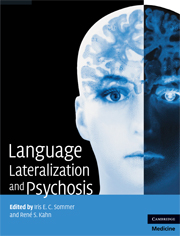Crossref Citations
This Book has been
cited by the following publications. This list is generated based on data provided by Crossref.
Badcock, Johanna C.
and
Hugdahl, Kenneth
2012.
Hallucinations.
p.
317.
Rapp, Alexander M.
Langohr, Karin
Mutschler, Dorothee E.
Klingberg, Stefan
Wild, Barbara
Erb, Michael
and
Zang, Yu-Feng
2013.
Isn’t it ironic? Neural Correlates of Irony Comprehension in Schizophrenia.
PLoS ONE,
Vol. 8,
Issue. 9,
p.
e74224.
Sandu, A.‐L.
Paillère Martinot, M.‐L.
Artiges, E.
and
Martinot, J.‐L.
2014.
1910s' brains revisited. Cortical complexity in early 20th century patients with intellectual disability or with dementia praecox.
Acta Psychiatrica Scandinavica,
Vol. 130,
Issue. 3,
p.
227.
Uomini, Natalie
and
Lawson, Rebecca
2017.
Effects of Handedness and Viewpoint on the Imitation of Origami-Making.
Symmetry,
Vol. 9,
Issue. 9,
p.
182.
Shadrina, Elena
and
Vol’pert, Yakov
2018.
Functional Asymmetry and Fingerprint Features of Left-Handed and Right-Handed Young Yakuts (Mongoloid Race, North-Eastern Siberia).
Symmetry,
Vol. 10,
Issue. 12,
p.
728.
Botha, Rudolf
2020.
Neanderthal Language.
Profico, Antonio
Zeppilli, Carlotta
Micarelli, Ileana
Mondanaro, Alessandro
Raia, Pasquale
Marchi, Damiano
Manzi, Giorgio
and
O’Higgins, Paul
2021.
Morphometric Maps of Bilateral Asymmetry in the Human Humerus: An Implementation in the R Package Morphomap.
Symmetry,
Vol. 13,
Issue. 9,
p.
1711.
Bardo, Ameline
Kivell, Tracy L.
Town, Katie
Donati, Georgina
Ballieux, Haiko
Stamate, Cosmin
Edginton, Trudi
and
Forrester, Gillian S.
2021.
Get a Grip: Variation in Human Hand Grip Strength and Implications for Human Evolution.
Symmetry,
Vol. 13,
Issue. 7,
p.
1142.
Bardo, Ameline
Town, Katie
Kivell, Tracy L.
Donati, Georgina
Ballieux, Haiko
Stamate, Cosmin
Edginton, Trudi
and
Forrester, Gillian S.
2022.
The Precision of the Human Hand: Variability in Pinch Strength and Manual Dexterity.
Symmetry,
Vol. 14,
Issue. 1,
p.
71.
Cuevas, Paulina
He, Yifei
Steines, Miriam
and
Straube, Benjamin
2022.
The Processing of Semantic Complexity and Cospeech Gestures in Schizophrenia: A Naturalistic, Multimodal fMRI Study.
Schizophrenia Bulletin Open,
Vol. 3,
Issue. 1,
McManus, Chris
2022.
Cerebral Polymorphisms for Lateralisation: Modelling the Genetic and Phenotypic Architectures of Multiple Functional Modules.
Symmetry,
Vol. 14,
Issue. 4,
p.
814.
Babik, Iryna
and
Lobo, Michele A.
2023.
Hand-Use Preferences for Reaching and Object Exploration in Children with Impaired Upper Extremity Functioning: The Role of Environmental Affordances.
Symmetry,
Vol. 15,
Issue. 12,
p.
2161.
Payette, Julie
Vaussenat, Fabrice
and
Cloutier, Sylvain G.
2024.
Heart Rate Measurement Using the Built-In Triaxial Accelerometer from a Commercial Digital Writing Device.
Sensors,
Vol. 24,
Issue. 7,
p.
2238.
Hodgins, Vegas
El Mouslih, Chaimaa
Rukh-E-Qamar, Hani
and
Titone, Debra
2024.
Multilingualism and psychosis: a pre-registered scoping review.
Bilingualism: Language and Cognition,
p.
1.
Bień, Marta
Drogoszewska, Barbara
Polcyn, Adam
Michcik, Adam
and
Garbacewicz, Łukasz
2024.
A Comparison of the Specific Facial Trauma Cases at the Department of Maxillofacial Surgery, Gdansk, Poland, from March 2019 to August 2023.
Journal of Clinical Medicine,
Vol. 13,
Issue. 11,
p.
3095.
Giovagnoli, Anna Rita
and
Parisi, Alessandra
2024.
Fifty Years of Handedness Research: A Neurological and Methodological Update.
Brain Sciences,
Vol. 14,
Issue. 5,
p.
418.



